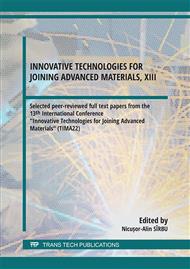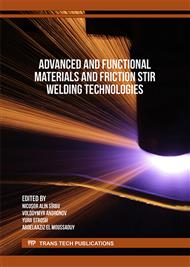p.109
p.121
p.131
p.143
p.155
p.163
p.175
p.185
p.193
Computer Aided Thermal Analysis of the FSW Tool Geometry
Abstract:
The thermal analysis will be realised in a Computer Aided Parametric Design program for three tools with different pin geometries to determine the transfer and distribution of the thermal energy produced during the process and to observe the influence of the pin geometry has on the distribution. Due to the fact that the joining process can be done at a lower temperature than the melting point of the material certain steps must be followed prior and correct selection of the machine’s parameters. Information on the parameters for specific materials and the preparation of the base material are readily available but considering the method of producing the thermal energy necessary for the process the quality of the weld is highly influenced by preheat time (of the material and tool), room temperature, cooling of the tool or work piece if the machine is equipped with such a configuration. We will observe in this study the effect of tool pin geometry over dwell time for reaching a uniform temperature of the tool in the shortest amount of time. The parameters used for the acquiring the data needed for the thermal analysis regarding tool material are tungsten carbide and the material of the plates will be aluminium 1200. The paper’s subject will be the realisation of a thermal analysis of the FSW (Friction Stir Welding) tools.
Info:
Periodical:
Pages:
155-162
Citation:
Online since:
August 2023
Keywords:
Price:
Сopyright:
© 2023 Trans Tech Publications Ltd. All Rights Reserved
Share:
Citation:



